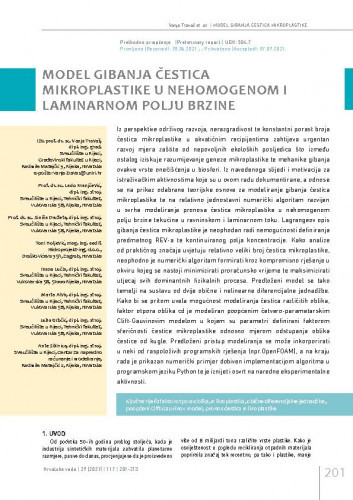Iz perspektive održivog razvoja, ne-razgradivost te konstantni porast broja čestica mikroplastike u akvatičnim recipijentima zahtjeva urgentan razvoj mjera zaštite od nepovoljnih ekoloških posljedica što između ostalog iziskuje razumijevanje geneze mikroplastike te mehanike gibanja ovakve vrste onečišćenja u biosferi. Iz navedenoga slijedi i motivacija za istraživačkim aktivnostima koje su u ovom radu dokumentirane, a odnose se na prikaz odabrane teorijske osnove za modeliranje gibanja čestica mikroplastike te na relativno jednostavni numerički algoritam razvijen u svrhe modeliranja pronosa čestica mikroplastike u nehomogenom polju brzine tekućine u ravninskom i laminarnom toku. Lagrangeov opis gibanja čestica mikroplastike je neophodan radi nemogućnosti definiranja predmetnog REV-a te kontinuiranog polja koncentracije. Kako analize od praktičnog značaja uvjetuju relativno veliki broj čestica mikroplastike, neophodno je numerički algoritam formirati kroz kompromisno rješenje u okviru kojeg se nastoji minimizirati proračunsko vrijeme te maksimizirati utjecaj svih dominantnih fizikalnih procesa. Predloženi model se tako temelji na sustavu od dvije obične i nelinearne diferencijalne jednadžbe. Kako bi se pritom uvela mogućnost modeliranja čestica različitih oblika, faktor otpora oblika cd je modeliran poopćenim četvero-parametarskim Clift-Gauvinovim modelom u kojem su parametri definirani faktorom sferičnosti čestice mikroplastike odnosno mjerom odstupanja oblika čestice od kugle. Predloženi pristup modeliranja se može inkorporirati u neki od raspoloživih programskih rješenja (npr. OPENFOAM), a na kraju rada je prikazan numerički primjer dobiven implementacijom algoritma u programskom jeziku Python te je iznijet i osvrt na naredne eksperimentalne aktivnosti.. From the sustainable development perspective, non-degradability and a constant microplastic particle increase in aquatic recipients require urgent development of protection measures against unfavourable environmental consequences. In order to do that, we firstly need an understanding of the microplastics genesis and the mechanics of its movement in the biosphere. This requires research activities documented in this paper. They are related to the presentation of a selected theoretical basis for modelling the movement of microplastic particles, and a relatively simple numerical algorithm developed for modelling the transport of microplastic particles in inhomogeneous field of fluid velocity in planar and laminar flow. The Lagrange’s description of the movement of microplastic particles is necessary because it is impossible to define the subject REV and the continuous concentration field. Analyses of practical importance require a relatively large number of microplastic particles, so it is necessary to develop a numeric algorithm through a compromise solution that attempts to minimise the computational time and maximise the impact of all dominant physical processes. Therefore, the proposed model is based on a system of two ordinary, nonlinear differential equations. In order to introduce the possibility of modelling particles of different shapes, the resistance factor of cd shape is modelled by a generalised four-parameter Clift and Gauvin model, where the parameters are defined by the spherical factor of a microplastic particle or the measure of a particle shape deviation from the sphere. The proposed modelling approach can be incorporated into some available software solutions (e.g. OPENFOAM). The end of the paper contains the presentation of a numerical example obtained by implementing the algorithm in the Python programming language and a review of the next experimental activities.
Sažetak
Dio sveska

